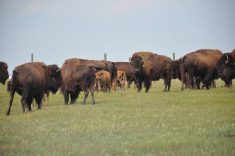The arrangement between man and livestock has been described as an ancient contract that provides benefits for both parties.
“(But) now there seems to be some stress on that ancient contract,” said Henry Janzen, a soil biochemist with Agriculture Canada’s research centre in Lethbridge.
Several factors are putting stress on that contract, he told a presentation at the University of Manitoba earlier this spring, including an urgent need to increase food production, a scarcity of clean water, waning energy reserves and the loss of habitat for all animals.
Read Also

Saskatchewan throne speech promises strong economy
Saskatchewan’s legislative agenda for the coming year will focus on meeting the challenges of new world trading relationships, said the speech from the throne.
He said livestock can contribute to the stress, because they:
• compete for human food;
• use lots of water;
• excrete millions of tonnes of nutrients that wind up in the water and tonnes of greenhouse gases that end up in the atmosphere.
However, he said livestock can also offer solutions to the problems facing the planet by:
• helping preserve ecosystems;
• recycling valuable nutrients back into the soil;
• converting inedible grasslands into protein.
“I believe that livestock are good for the land … but not all ways of raising them are good.”
Owen McAuley, who farms near McAuley, Man., agreed with Janzen but phrased his answer differently.
“This isn’t about livestock’s fault, it is the fault of people,” said McAuley, who participated in a panel discussion following Janzen’s lecture.
“I think the people managing livestock are hurting themselves, more so than the livestock are hurting the land, in terms of shifting people’s attitudes (against) livestock…. This is a huge cost to the industry as a whole.”
Janzen said livestock producers need to change and improve the system so that cattle, sheep and pigs become part of the solution and the public views livestock as part of the solution.
Allan Preston, a former Manitoba Agriculture assistant deputy minister and farmer near Hamiota, Man., said nutrient recycling on his farm is an example of how livestock can be beneficial.
He said his canola crop yielded 55 bushels per acre last year, using only 30 pounds per acre of nitrogen and 10 lb. of phosphorus.
His neighbour’s crop also yielded 55 bu. per acre, but he applied 110 lb. of nitrogen and 40 lb. of phosphorous.
“Do you know what the difference was? The manure from my livestock. The organic matter in my soil was running at seven or eight percent and the organic matter in my neighbour’s soil was about two or three percent.”
Janzen said producers have many options when trying to improve livestock practices, but they need to accept that choices usually involve trade-offs between competing objectives.
“Intuitively we seek win-win solutions, but nature is not so accommodating.”
He said another challenge is that scientific research has become highly fragmented.
Academics need to think more broadly about all the issues involved in livestock production, such as food, fuel, economics, livelihoods, habitat and greenhouse gas emissions.
“We are getting more and more expert in smaller and smaller pieces.”
As well, researchers, farmers and policy makers cannot simply depend on logic and evidence to determine the best practices for raising livestock.















